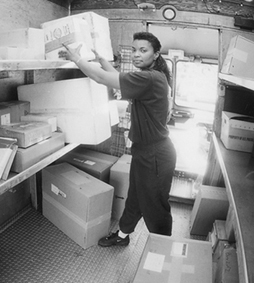The transportation and warehousing industry is fraught with challenges to worker health and safety. Those involved in loading and unloading of cargo and in storing, stacking and retrieving materials are prone to musculoskeletal injuries, slips and falls due to uncertain, irregular or slippery work surfaces and being struck by falling objects. See figure 1. Those operating and maintaining vehicles and other machinery are not only vulnerable to such injuries but also to the toxic effects of fuels, lubricants and exhaust fumes. If ergonomic principles are not heeded in the design of seats, pedals and instrument panels, drivers of trains, planes and motor vehicles (those used in warehousing as well on roads) will not only be subject to musculoskeletal disorders and undue fatigue, but will also be prone to operating mishaps that can lead to accidents.
Figure 1. Lifting parcels above shoulder height is an ergonomic hazard.
Teamster Union
All workers—and the general public as well—may be exposed to toxic substances in the event of leaks, spills and fires. Since much of the work is done out-of-doors, transportation and warehousing workers are also subject to extremes of weather such as heat, cold, rain, snow and ice, which can not only make the work more arduous but also more dangerous. Aviation crews must adjust to changes in barometric pressure. Noise is a perennial problem for those operating or working near noisy vehicles and machinery.
Stress
Perhaps the most pervasive hazard in this industry is work stress. It has many sources:
Adjusting to work hours. Many workers in this industry are burdened by the necessity of adjusting to changing shifts, while flight crews who travel long east-west or west-east distances must adjust to changes in circadian body rhythms; both of these factors may cause drowsiness and fatigue. The danger of functional impairment due to fatigue has led to laws and regulations stipulating the number of hours or shifts that may be worked without a rest period. These are generally applicable to aviation flight crews, railroad train crews and, in most countries, drivers of road buses and trucks. Many of the last group are independent contractors or work for small enterprises and are frequently forced by economic pressures to flout these regulations. There are always emergencies dictated by problems with traffic, weather or accidents which require exceeding the work hours limits. Led by the airlines, large transportation companies are now using computers to track employees’ work schedules to verify their compliance with the regulations and to minimize the amount of down time for both workers and equipment.
Timetables. Most passenger and a good part of freight transport is guided by timetables stipulating departure and arrival times. The necessity of keeping to schedules which often allow too little leeway is often a very potent stressor for the drivers and their crews.
Dealing with the public. Meeting the sometimes unreasonable and often forcefully expressed demands of the public can be a significant source of stress for those dealing with passengers at terminals and ticket offices and en route. Drivers of road transport must contend with other vehicles, traffic regulations and diligent highway traffic officers.
Accidents. Accidents, whether due to equipment failure, human error or environmental conditions, place the transportation industry at or near the top of listings of occupational fatalities in most countries. Even when a particular worker’s injuries may not be serious, post-traumatic stress disorder (PTSD) can lead to profound and prolonged disability, and in some instances it can prompt changing to another job.
Isolation. Many employees in the transportation industry work alone with little or no human contact (e.g., truck drivers, workers in control rooms and in railroad switch and signal towers). If problems arise, there may be difficulty and delays in getting help. And, if they are not kept busy, boredom may lead to a drop in attentiveness that can presage accidents. Working alone, especially for those driving taxis, limousines and delivery trucks, is an important risk factor for felonious assaults and other forms of violence.
Being away from home. Transportation workers are frequently required to be away from home for periods of days or weeks (in the maritime industry, for months). In addition to the stress of living out of a suitcase, strange food and strange sleeping accommodations, there is the reciprocal stress of separation from family and friends.
Health problems
Most industrialized countries require transportation workers, especially drivers and operating crew members, to take periodic medical examinations to verify that their physical and mental capacities meet the requirements established by regulations. Visual and hearing acuity, colour vision, muscular strength and flexibility and freedom from causes of syncope are some of the factors tested for. Accommodations, however, make it possible for many individuals with chronic disorders or disabilities to work without danger to themselves or others. (In the United States, for example, employers are mandated by the federal Americans With Disabilities Act to provide such accommodations.)
Drugs and alcohol
Prescription and over-the-counter medications taken for a variety of disorders (e.g., hypertension, anxiety and other hyperkinetic conditions, allergies, diabetes, epilepsy, headaches and the common cold) may cause drowsiness and affect alertness, reaction time and coordination, especially when alcoholic beverages are also consumed. Abuse of alcohol and/or illegal drugs is found frequently enough among transportation workers to have led to voluntary or legislatively mandated drug testing programmes.
Summary
The health and safety of workers in the transportation and warehousing industry are critical considerations, not only for the workers themselves but also for the public being transported or involved as bystanders. Safeguarding health and safety, therefore, is the joint responsibility of the employers, the employees and their unions and governments on all levels.

